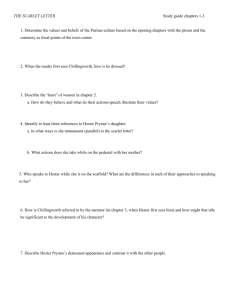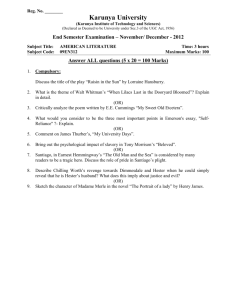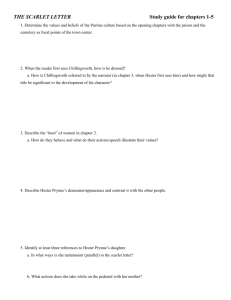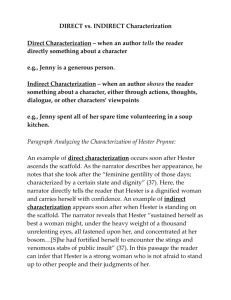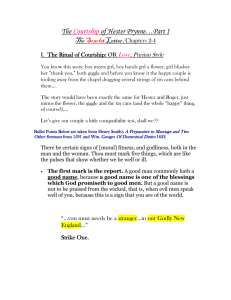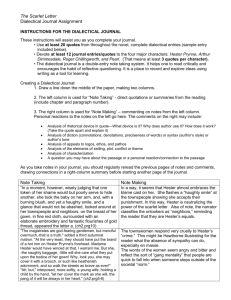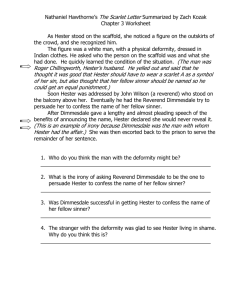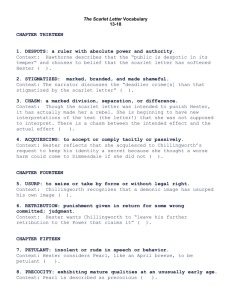5 Paragraph Essay.doc
advertisement
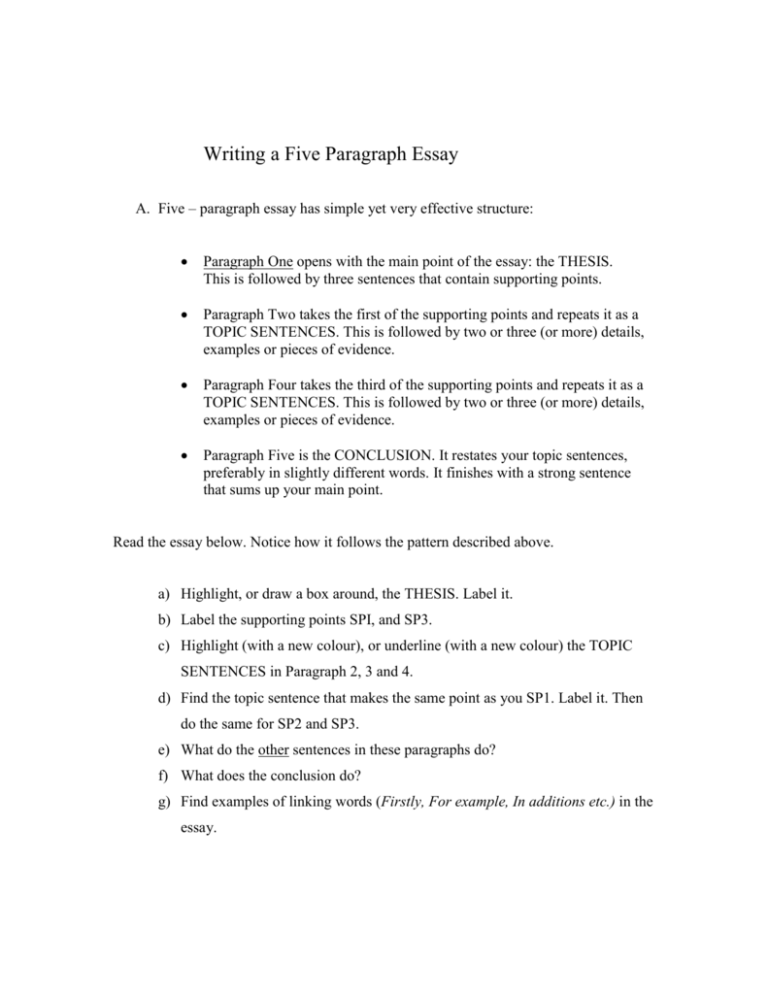
Writing a Five Paragraph Essay A. Five – paragraph essay has simple yet very effective structure: Paragraph One opens with the main point of the essay: the THESIS. This is followed by three sentences that contain supporting points. Paragraph Two takes the first of the supporting points and repeats it as a TOPIC SENTENCES. This is followed by two or three (or more) details, examples or pieces of evidence. Paragraph Four takes the third of the supporting points and repeats it as a TOPIC SENTENCES. This is followed by two or three (or more) details, examples or pieces of evidence. Paragraph Five is the CONCLUSION. It restates your topic sentences, preferably in slightly different words. It finishes with a strong sentence that sums up your main point. Read the essay below. Notice how it follows the pattern described above. a) Highlight, or draw a box around, the THESIS. Label it. b) Label the supporting points SPI, and SP3. c) Highlight (with a new colour), or underline (with a new colour) the TOPIC SENTENCES in Paragraph 2, 3 and 4. d) Find the topic sentence that makes the same point as you SP1. Label it. Then do the same for SP2 and SP3. e) What do the other sentences in these paragraphs do? f) What does the conclusion do? g) Find examples of linking words (Firstly, For example, In additions etc.) in the essay. Zoos are an unsuitable environment for wild animals and should, therefore, be abolished. Firstly, zoo animals are kept in a very confined area compared with their vast natural habitat. Secondly, breeding programmes are far less successful than zoo claim. Thirdly, zoo animals are exposed to many diseases and other dangers. Zoo animals are usually kept in very cramped enclosures and do not behave like their wild counterparts. Polar bears, for example, are given about 10 meters of walking space whereas in their Arctic home they roam for many hundreds of kilometers. Similarly, primates, big cats and birds are often confined in cages where they lack exercise and stimulation. Many animals develop unnatural habits such as pacing back and forth or swaying form side to side. Supporters of zoos argue that they help to conserve endangered species, bit in fact they are not very good at this. Even the world famous panda breeding programme has been very costly and unsuccessful. Also, zoo life does not prepare animals for the challenges of life in the wild. In Colorado died from starvation even though the area was full of hares, which are a lynx’s natural prey. The zoo is an unnatural environment that exposes animals to numerous dangers. Diseases often spread between species that would never live together naturally. For examples, many Asian elephants have died in US zoos after catching herpes from African elephants. Furthermore, zoo animals are often exposed to chemicals, solvents and other toxic substances. Finally, it is common for visitors to tease and provoke caged animals. In conclusion, therefore, it is not true to say that zoos are educational or that they help to project endangered species. In reality, they only teach us how wild animals behave when they are confined in small spaces. Breeding programmes provide zoos with good publicity, but in fact most of them are failures. Finally, zoo animals are probably more at risk of dying from disease or poisoning than their wild counterparts. It is time that we abolished these cruel institutions! Language and Creative Arts (A) – 4974AC Learning Outcome 2 MODEL ANSWER In this very good response the student has chosen to write about an art work. We will be doing a practice exercise in class on a piece of writing. For your assessment task you will be writing a review or a critical article on the film American Beauty. I will provide you with models. The outcome is that you will learn how to respond critically to various creative forms. Joy Hester, an Australian Artist f the 1940s and 1950s produced some of the most powerfully bold and emotive works of art in her time. She produced several hundred drawings, poems and a handful of oil paintings. While not recognized for the artistic abilities in her lifetime, Hester is now being recognized for her achievements as one of Australia’s most significant artists. One of the most powerfully emotive works that Hester produced was a self-portrait titled Woman in Fur Coat (1955-56), which a woman’s head and shoulders are covered by a ‘Fur Coat’. The woman’s face which takes up most of the drawing is the focal point of this work. The woman’s eyes stare, the dark lines under the eyes and rough looking texture of the hair gives the appearance of someone tired, ill and vulnerable. It is an honest and somewhat brutal representation of the artist wracked by ill health. Janice Burke, in referring to Joy Hester’self-portraits states that “Joy did not, however in all but a few works turn her attention to herself…Yet when she did render her own features she did so with the same penetrating honesty that marks her entire oeuvre. “Hester did not attempt to beautiful or disguise her self image in this self-portrait, making Woman in Fur Coat a true representation of what she was experiencing at the time. Hester utilizes a specific medium and technique to convey the depth of her emotional experience. The medium she used for Woman in Fur Coat, and preferred medium for the majority of her work was Chinese ink and brush on paper. When applied to stark white paper it was bold and immediate and, gave a dramatic mood. Its simplicity allowed her to work spontaneously and explore her inner emotions as a stream of consciousness. She preferred drawing, she said, “because it presented no barrier”. This medium is fully extended by Hester’s technique of using contrasts between light key areas and dark key areas to create a sense of drama. Her particular technique is also reflected in the way that the face is delineated in thick black strokes as are the eyes that stare out, framed buy sharp creases. Hester also, as Donald Williams states, “Like Munch, achieved an emotional impact by distorting facial features, such as eliminating the nose, distorting the eyes or placing them on wheels outsides the face, and by giving the face an expression of despair, pain or pleasure,” The eyes, in particular are pivotal to conveying meaning, a recurring distinguishing characteristic of Hester’s work. They distorted and emotive. Jacklyn Peters captures the strength of Hester’s use of this particular medium when she states that she “liked in Joy Hester’s work her ability to make vacant spaces full, and purposeful. In a single broad wash of line she can lead you from that empty space to a point of centrality to the emotion of the drawing.” Hester’s ability to express emotion in her artwork with, minimal use of lines ad an economy of means further demonstrate her extraordinary artistic abilities. Hester’s use of medium an technique thus serves to convey the intense feeling of her subject matter – her personal; anguish conveyed through the use of; large bold areas of black ink on white, balanced with expressive lines and areas of texture or pattern, It is in the words of Burke “a face-and a personality stripped bare, fully revealed an fearless”. Chee, Broos and Slade, compare Hester with Frida Kahlo in stating that “like Kahlo, Australian artist, Joy Hester, expresses pain, emotion and passion in hr work. Her distorted bold ink drawings reflect the intensity of her feelings”. In observing Woman in Fur Coat, I too saw the complete honesty in which Hester represented her self image that is confronting as it reveals so much about her experience. Hester reflected upon the events of her life in an individual and powerful way, creating emotive and expressive artwork. In the early 1940s, Hester had been diagnosed with Hodgkins disease and was in remission form 1947 to 1955 when symptoms reappeared, triggering unprecedented creative growth in Hester’s artistic development some of which were extraordinary depictions of old age. Hester lost her battle with the disease and died in December 1960 aged 40. Burke, J (2001) Joy Hester, Random House Australia Pty Ltd, Sydney Williams, D (1999), The Story of Australia Art – In Our Image, McGraw-Hill Australia Pty Ltd, Australia, Fourth Edition, p.130 Chee, L, Broos, L Slade, L (1996), In the Picture – Framing the Visual Arts, Oxford University Press, Australia, p 7 Htpp://www/curtin.edu.au/learn/unit/vsw14/menu/studioduscussion/messages/31.htmi,5 may 2003 Semester 1, 2005 EVENTS 1a: LACA ASSESSMENT SCHEDULE COMMENTARY DUE WEEK 6 You will work in groups of 3 or 4 for the first two assessments. Each group must choose the same theme 10% Each person will collect two texts on the group theme from different creative arts areas. Identify at least five distinguishing features of each text. Write a paragraph on each text explaining how meaning is conveyed by the five distinguishing features identified. (150 – 300 words per text) EVENTS Ib GROUP ORAL PRESENTATION DUE WEEK 7 Each group member will present one text they used in event 1a. Each presentation in the group should be from a different area of study on the group theme. 10% Each group member will identify at least five distinguishing features of their text and explain how it conveys meaning Each group member will use oral presentation skills and a/v aids to present their text. 3 -6 minutes EVENTS 2: CRITICAL RESPONSE DUE WEEK 11 30% Choose a text from a different creative arts area to those used for event 1. Identify the criteria for making critical responses to this creative art from with reference to at least three critics. Apply the criteria to the text and evaluate how effectively they work o the audience or responder to the text. Support your response with particular reference to and examples form the text (750 – 100 words) EVENTS 3: ESSAY DUE WEEK 17 50% Compare and contrast two texts which differ in form but explore the same therme. Discuss the different techniques used in each from with examples from text and evaluate their effect on the audience. Use conventional essay format including Harvard in text referencing & bibliography (1400 – 1600) DRAMATIC TECHNIQUES MACBETH Drama depends on CONFLIT which may be: Internal OR External eg- soliloquies eg- Arguments Situation Physical Action between Macbeth & L. Macbeth naming of the succession Macduff kills Macbeth DRAMATIC TENSION Used to accentuate conflict - created by setting which is described in dialogue of the characters as omimous and foreboding. DRAMATIC IRONY Adds to dramatic tension – comes from action where the audience knows more than the character. Eg initial ridding words of the Witches, ridding words of the apparitions later. POETIC DIALOGUE Creates IMAGERY that threads through the play evoking atmosphere/underlining themes/giving insights into characters eg image of blood/darkness/disease/nature/clothing/supernatural. Creates SYMBOLS Eg at the end of the play Macbeth’s castle symbolise Hell DRAMATIC CONTRAST Contradiction stets up audience expectations to “read” the worst into their response eg paradox “fair is foul” Contrast between characters where minor characters like Banquo, Duncan and Lady Macduff are used as dramatic foils against the major characters LACA THE VISUAL ARTS Recommended reading: Berger, John 1977 Ways of Seeing, Penguin, London 750.1/WAYS Januszczak, Waldermar 2001 Techniques of the World’ Great Painters Books, London 751.4/TECH Quantum Cumming, Robert 1995 Annotated Art, Dorling Kindersley, London 750.11/CI,, Six Guidelines (from Cumming) Subject Theme Meaning Message’ Oil/water/fresco/impasto Medium Brush stroke Palette knife Allegory Technique Symbolism Space and Light Historical Style The illusion of space and light on a flat surface Composition Perspective Colour Line Medieval Renaissance Personal Interpretation A personal exploration of meaning
